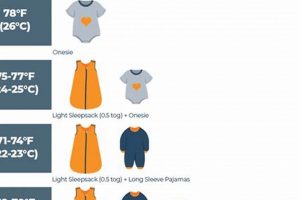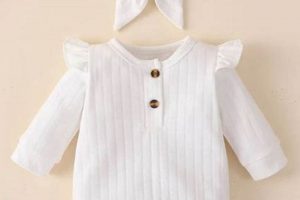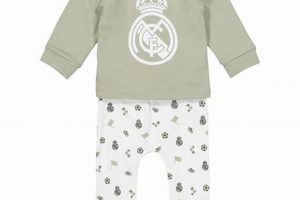A resource providing recommendations on appropriate clothing for infants based on ambient temperature. These guides often suggest layering strategies and types of fabrics suitable for different temperature ranges, aiming to maintain a baby’s comfort and safety. An example would be a chart suggesting a lightweight cotton onesie for temperatures between 75-78F (24-26C).
Accurate selection of infant garments according to weather conditions is vital for preventing overheating or chilling, both of which can pose health risks. Historically, parents have relied on intuition and anecdotal evidence, but standardized guidelines offer a more scientific and reliable approach. These recommendations aid in ensuring optimal thermal regulation, potentially minimizing discomfort and related health issues.
The following discussion will delve into specific temperature ranges, recommended clothing articles for each range, factors influencing individual baby needs, and practical considerations for using such guidelines effectively. The aim is to provide comprehensive understanding that will enable informed decisions regarding infant attire.
Guidance for Infant Clothing Selection Based on Ambient Temperature
The following recommendations offer practical advice for utilizing temperature guidelines to ensure an infant’s comfort and well-being.
Tip 1: Monitor Room Temperature Regularly: Implement a room thermometer to obtain precise ambient temperature readings. This practice mitigates subjective assessments and ensures data-driven clothing choices.
Tip 2: Prioritize Layering: Employ multiple thin layers instead of a single heavy garment. This strategy permits flexible adjustments as the temperature fluctuates throughout the day or night. For instance, a long-sleeved onesie beneath a light sleep sack allows for easy removal of a layer if needed.
Tip 3: Choose Natural Fibers: Opt for breathable materials such as cotton, merino wool, or bamboo. These fabrics facilitate air circulation, reducing the risk of overheating and promoting moisture absorption.
Tip 4: Assess for Signs of Discomfort: Observe the infant for indicators of overheating or chilling, including flushed skin, sweating, shivering, or irritability. Adjust clothing accordingly based on these objective signs.
Tip 5: Account for Individual Variability: Recognize that each infant possesses unique metabolic rates and sensitivities to temperature. Premature infants or those with underlying health conditions may require different clothing adjustments.
Tip 6: Consider Activity Level: Adjust clothing based on the infant’s level of activity. An infant actively playing may require fewer layers than one who is sleeping or sedentary.
Tip 7: Exercise Caution with Overdressing: Overdressing is a more prevalent concern than underdressing. Err on the side of fewer layers, particularly during warmer months, to prevent overheating, which can increase the risk of Sudden Infant Death Syndrome (SIDS).
Adherence to these guidelines, alongside close observation of the infant, promotes a safe and comfortable environment, contributing to overall well-being. The selection of appropriate attire supports healthy thermal regulation and minimizes potential health risks.
The subsequent section will address frequently asked questions concerning clothing selection, addressing common concerns and providing further clarification.
1. Comfort
The primary objective of using resources providing recommendations on appropriate clothing for infants, based on ambient temperature, is to ensure comfort. An infant experiencing thermal discomfort, whether due to overheating or chilling, is prone to distress, manifested through crying and restlessness. These guides offer data-driven suggestions to mitigate these discomforts, preventing unnecessary stress on the infant and facilitating better sleep patterns. For example, if an infant is dressed in heavy fleece during a summer heatwave, discomfort will arise, leading to potential health issues.
The absence of comfort directly impacts various aspects of infant well-being. Prolonged discomfort disrupts sleep, potentially affecting growth and development. Irritability stemming from temperature imbalances can impede feeding routines. Furthermore, constant distress can elevate cortisol levels, negatively impacting the infants immune system. Practical application involves constant monitoring and adjustments, ensuring a comfortable environment, which can have significant and positive impacts on the infant’s overall health.
In summary, the connection between comfort and recommended infant clothing selection based on temperature is direct and consequential. Addressing thermal comfort is not merely a matter of preference; it is a crucial factor in infant health, sleep, and development. Challenges lie in adapting the general guidelines to individual needs and recognizing subjective signs of distress. A proactive approach to maintaining thermal comfort, guided by accurate resources and attentive observation, underscores the critical role of clothing selection in infant care.
2. Safety
Infant safety is inextricably linked to resources that offer recommendations on appropriate attire based on ambient temperature. Overheating, a potential consequence of inappropriate clothing, elevates the risk of Sudden Infant Death Syndrome (SIDS). Conversely, inadequate clothing in cold environments can lead to hypothermia. Guidelines mitigate these risks by providing evidence-based recommendations. For instance, a suggestion against swaddling infants tightly during warmer months directly reduces the potential for overheating, contributing to a safer sleep environment.
The proper use of temperature-based clothing recommendations extends beyond SIDS prevention. Maintaining stable body temperature supports optimal physiological function, including immune response and metabolic processes. Infants cannot regulate their body temperature as effectively as adults; therefore, external assistance through appropriate attire is crucial. Real-world scenarios, such as sudden weather changes, highlight the importance of adaptable clothing strategies suggested in these resources. Layering, for example, allows caregivers to quickly adjust the infant’s clothing to prevent temperature extremes, increasing safety and comfort.
In conclusion, safety is a central component of resources providing recommendations on appropriate attire for infants based on ambient temperature. Through evidence-based guidelines, these resources aim to prevent temperature-related health risks, contributing to the overall well-being and protection of infants. A proactive approach, including consistent monitoring and informed decision-making regarding clothing, reinforces the practical significance of safety in infant care. The challenges lie in adapting general guidelines to specific infant needs, and remaining current with evolving safety recommendations.
3. Layering
Layering is a fundamental principle underpinning the application of temperature guidelines for infant clothing selection. This strategy involves dressing an infant in multiple thin garments instead of a single, thick one, allowing for adaptable temperature regulation based on ambient conditions and the infant’s activity level.
- Flexibility and Adaptability
Layering offers unparalleled flexibility in adjusting to fluctuating temperatures. Caregivers can add or remove layers as needed, preventing overheating or chilling. For example, a long-sleeved onesie under a lightweight sleep sack provides warmth but allows for removal of the sleep sack during warmer periods. This adaptability is crucial for maintaining optimal thermal comfort.
- Air Circulation and Moisture Control
Multiple thin layers promote better air circulation compared to a single heavy garment. This enhanced airflow reduces the risk of overheating and facilitates the evaporation of moisture, preventing skin irritation. Natural fibers like cotton or merino wool are particularly effective in this regard, as they allow the skin to breathe and wick away perspiration.
- Individual Comfort Customization
Layering allows for a customized approach to infant comfort. Each infant possesses unique metabolic rates and sensitivities to temperature. By layering, caregivers can fine-tune the clothing ensemble to meet the specific needs of the individual child. This individualized approach contrasts with the one-size-fits-all nature of relying solely on a single heavy garment.
- Practical Application in Varying Environments
The layering principle is applicable across a wide range of environments. Whether indoors or outdoors, layering provides a practical means of adjusting to temperature variations. For instance, during outdoor excursions, additional layers such as a light jacket or hat can be added to protect against cooler temperatures or wind, while layers can be removed once indoors to prevent overheating.
In summary, layering is a core element in the effective implementation of temperature guidelines for infant clothing. Its adaptability, promotion of air circulation, and capacity for individual customization make it an indispensable strategy for ensuring infant comfort and safety in diverse thermal environments. The ability to adjust to specific infant needs, in conjunction with external ambient conditions, positions layering as a key component for responsible infant care.
4. Materials
Material selection constitutes a critical element in translating temperature guidelines for infant clothing into practical application. The inherent properties of various fabrics directly impact their suitability for different ambient temperatures and infant needs. The following points detail significant aspects of material considerations.
- Breathability and Airflow
Breathability refers to a fabric’s capacity to allow air to circulate, mitigating the risk of overheating and promoting moisture evaporation. Natural fibers, such as cotton and merino wool, exhibit superior breathability compared to synthetic counterparts like polyester. Consequently, temperature guides frequently recommend lightweight cotton garments for warmer temperatures to facilitate airflow and prevent heat retention.
- Moisture-Wicking Properties
Moisture-wicking fabrics draw perspiration away from the skin, keeping the infant dry and comfortable. Materials like merino wool and bamboo rayon possess inherent moisture-wicking capabilities, making them well-suited for active infants or warmer climates. Guides often suggest these materials for layering, particularly during activities where perspiration is likely.
- Thermal Insulation
Thermal insulation refers to a material’s ability to trap heat and maintain warmth. Fabrics like fleece and heavier knits offer greater insulation, rendering them appropriate for colder temperatures. Guides typically advise using these materials as outer layers during colder months, ensuring the infant retains adequate body heat.
- Sensitivity and Irritation
Infant skin is more delicate and prone to irritation than adult skin. Consequently, selecting hypoallergenic and non-irritating materials is paramount. Organic cotton, free from dyes and harsh chemicals, is often recommended in temperature guides to minimize the risk of allergic reactions and skin sensitivity. Synthetic fabrics, particularly those treated with chemicals, may pose a higher risk of irritation.
These considerations underscore the significance of material selection in adhering to temperature guidelines for infant clothing. The appropriate choice of fabric ensures optimal thermal regulation, minimizes discomfort, and reduces the risk of skin irritation, contributing to the overall well-being of the infant. Adherence to these guidelines, supported by mindful material selection, constitutes a crucial aspect of responsible infant care.
5. Monitoring
Monitoring serves as a crucial, active component in effectively utilizing temperature guides for infant clothing. These guides provide a foundational framework; however, their successful application hinges on continuous observation of the infant. Failure to monitor can negate the benefits of even the most meticulously chosen clothing, potentially leading to overheating or chilling. For example, a guide may recommend a specific layering strategy for a particular temperature range, but if the infant exhibits signs of sweating despite adhering to these recommendations, the caregiver must remove a layer, demonstrating the necessity of real-time feedback.
The practice of monitoring extends beyond visual cues. Tactile assessment, such as feeling the infant’s nape for clamminess or coldness, offers valuable insights into their thermal state. Furthermore, behavioral changes, including irritability or lethargy, can serve as indicators of temperature discomfort. Consistent monitoring enables caregivers to promptly adjust the infant’s clothing, maintaining an optimal thermal environment. The absence of monitoring renders any pre-determined clothing plan ineffective, as individual needs and environmental conditions vary continuously.
In conclusion, monitoring is not merely a supplementary action, but an indispensable element in the successful application of temperature guides for infant clothing. The guidelines provide a starting point, while continuous observation and assessment of the infant’s condition informs real-time adjustments, ensuring optimal thermal comfort and safety. The challenge lies in discerning subtle cues and responding proactively, transforming a static guideline into a dynamic and responsive care strategy.
6. Individualization
Temperature guides for infant clothing provide a general framework, but their effective implementation necessitates individualization. Physiological factors, such as metabolic rate, weight, and prematurity, influence an infant’s ability to regulate body temperature. Consequently, strict adherence to generalized guidelines without considering these individual variables can lead to either overheating or chilling. For example, a premature infant with limited fat reserves may require additional layers compared to a full-term infant in the same ambient temperature, despite both infants being subject to the same guide.
The importance of individualization extends to behavioral aspects. An active infant generates more heat than a sleeping infant, necessitating adjustments in clothing even within the same temperature range. Monitoring for signs of discomfort, such as flushed skin, sweating, or shivering, is paramount. Adjustments should then be made based on these observations, overriding generic recommendations if necessary. Real-world examples include an infant with a fever, who may require fewer layers despite ambient temperature, or an infant with eczema, whose sensitive skin may necessitate specific fabric choices irrespective of general guidelines.
In summary, while temperature guides provide a valuable starting point, individualization is crucial for ensuring infant comfort and safety. The guides should be viewed as tools to inform decision-making, rather than inflexible rules. Challenges lie in discerning subtle cues and adapting recommendations to the unique needs of each infant. Ultimately, successful implementation of temperature-based clothing strategies requires a combination of informed decision-making and continuous monitoring, emphasizing the practical significance of individualized care.
7. Prevention
The utilization of resources providing recommendations on appropriate attire for infants, based on ambient temperature, is inherently preventative. These guides aim to preemptively mitigate potential health risks associated with inadequate thermal regulation in infants. Overheating increases the risk of Sudden Infant Death Syndrome (SIDS), while chilling can lead to hypothermia or exacerbate respiratory issues. By adhering to the suggested guidelines, caregivers actively work to prevent these adverse outcomes, fostering a safer environment for the infant. For instance, guidelines advising against overdressing during sleep directly address the prevention of overheating, a known SIDS risk factor.
The preventative aspect extends beyond acute conditions. Maintaining a stable body temperature supports optimal immune function and metabolic processes, contributing to long-term health. Temperature-related discomfort can disrupt sleep patterns and feeding routines, potentially impacting growth and development. By employing temperature guides, caregivers proactively address these potential disruptions, promoting consistent and healthy developmental trajectories. Practical application includes consistently monitoring room temperature and adjusting clothing accordingly, preventing temperature extremes that may compromise the infant’s well-being.
In conclusion, prevention is a cornerstone of resources providing recommendations on appropriate attire for infants based on temperature. These guidelines serve as a proactive strategy to minimize the risk of temperature-related health issues, both acute and chronic. The challenge lies in balancing generalized recommendations with individual infant needs and environmental variations. However, the underlying principle remains consistent: informed decision-making and proactive action are paramount in safeguarding infant health and promoting optimal development.
Frequently Asked Questions Regarding Temperature Guidelines for Infant Attire
The following section addresses common queries and concerns related to the application of resources providing recommendations on appropriate clothing for infants based on ambient temperature. The intent is to provide clear, concise, and evidence-based answers to frequently raised questions.
Question 1: How frequently should an infant’s clothing be adjusted based on temperature recommendations?
Adjustments should be made in response to variations in ambient temperature, activity level, and individual signs of discomfort. Regular monitoring, combined with consideration of the infant’s specific needs, determines the frequency of clothing modifications. Sudden changes in weather or activity necessitate immediate reassessment.
Question 2: Are temperature guidelines universally applicable to all infants?
Temperature guidelines offer a general framework, but individualization is crucial. Factors such as prematurity, metabolic rate, and underlying health conditions influence an infant’s thermal regulation capabilities. Caregivers must adapt recommendations to meet the specific needs of each infant, prioritizing observation and responsiveness.
Question 3: What constitutes an objective sign of overheating or chilling?
Objective signs of overheating include flushed skin, sweating, rapid breathing, and irritability. Indicators of chilling encompass shivering, cold extremities, lethargy, and pale skin. Prompt action, such as removing or adding layers, should be taken upon observing these signs.
Question 4: How reliable are digital thermometers in assessing ambient temperature for clothing selection?
Digital thermometers provide a more precise assessment compared to subjective estimations. Ensure the thermometer is calibrated and positioned away from direct sunlight or drafts for accurate readings. Consistency in temperature monitoring facilitates informed clothing choices.
Question 5: Do temperature guides account for humidity levels?
Most temperature guides primarily focus on temperature but high humidity can exacerbate thermal discomfort. In humid conditions, prioritize breathable fabrics and avoid overdressing, as perspiration cannot evaporate effectively. Adjustments should be made to prevent both overheating and skin irritation.
Question 6: What is the recommended approach for nighttime clothing selection based on temperature guidelines?
Nighttime clothing selection should prioritize safety and comfort. Avoid heavy blankets or loose bedding, as these increase the risk of SIDS. Instead, opt for a fitted sleep sack or wearable blanket appropriate for the ambient temperature, ensuring the infant remains comfortably warm without overheating.
In summary, the application of temperature guidelines for infant attire requires a combination of knowledge, vigilance, and responsiveness. Regular monitoring and adjustments are crucial for optimizing infant comfort and well-being.
The following section will provide a comprehensive conclusion for the overall article.
Conclusion
This article has explored the utility and importance of a temperature guide for baby clothes. It has elucidated the crucial role these guidelines play in ensuring infant comfort and safety by providing evidence-based recommendations for clothing selection based on ambient temperature. Key aspects, including comfort, safety, layering, material selection, monitoring, individualization, and prevention, were analyzed to demonstrate the multifaceted nature of these resources and their impact on infant well-being.
Effective utilization of temperature guidelines requires informed decision-making, consistent monitoring, and a responsive approach to individual infant needs. As research evolves and new insights emerge, maintaining awareness of current recommendations and adapting practices accordingly is essential. Prioritizing infant health and safety through responsible implementation of these guides remains a critical responsibility for caregivers.







